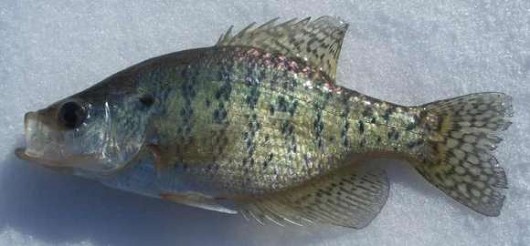White Crappie
-
Scientific NamePomoxis annularis
-
NativeNo
-
Identification
 White crappie. Photo courtesy of Corey Geving, webmaster at roughfish.com.
White crappie. Photo courtesy of Corey Geving, webmaster at roughfish.com.- Deep laterally compressed body and small head, with a depression in the profile above the eyes and close to the pointed snout
- Large eyes and large, oblique mouths
- Large rounded dorsal and anal fins nearly equal in size
- 13-15 dorsal, 16-18 anal, 5 pelvic, and 13-14 pectoral fin rays
- 5-6 dorsal, 6-7 anal, and 1 pelvic spine(s)
- 34-46 scales along the arched lateral line
- Iridescent olive-green backs, silvery-white sides with up to 10 dark, iridescent vertical bars
- Dorsal, anal, and caudal fins have dark checkered spots
- Breeding males become very dark, with the head and breast turning nearly completely black
-
Life History
White Crappie (pronounced "croppie") are most common in warm, turbid lakes, reservoirs, and river backwaters, and in streams with safe areas where high flow periods can be avoided. Temperatures between 27°C and 29°C are optimal but anywhere warmer than 31°C is avoided. While White Crappie have been collected in areas with salinities of 10 ppt, it is rare for them to be found in estuarine waters. They also survive well in areas of increased alkalinity, turbidity, and flow when compared similar species, but have little tolerance for low dissolved oxygen levels (2-4 mg/L). White Crappies can usually be observed schooling around submerged logs or boulders in quiet water 2-4 m deep, except in the evening and early morning when they move out into open water to feed. Their feeding strategy mostly involves floating in midwater, using their flat shape as camouflage, and quickly grabbing everything that they can using their protruding jaw and short gill rakers. This adaptation allows them a diversity of prey items, most commonly planktonic crustaceans and small fish, but also aquatic insects when available. Zooplankton are especially important for younger white crappies.
White Crappies reach maturity in their second or third spring when they have grown to 10-20 cm TL. Spawning begins in April or May when temperatures reach 17-20°C. Nests are built in colonies underneath or close to overhanging bushes or banks, in water less than 1 m deep. A nest is a shallow depression in hard clay bottom, near or in a bed of aquatic vegetation or submerged plant debris to which the fertilized eggs can adhere. Most males guard the nests until the embryos hatch but it is believed that are multiple mating strategies for males that may relieve some of this duty (see Bluegill page for potential scenario). Each female can lay 970-326,000 eggs per season. The newly hatched larvae are planktonic and will return to the water column to feed even when they have settled into aquatic vegetation as juveniles. Californian growth rates are on average slower than those found in the native range of White Crappie, with most fish reaching 5-10 cm FL in their first year and 20-27 cm in their fourth. Few live to be older than 7-8 years or grow larger than 35 cm FL.
-
Links to Other ResearchN / A
